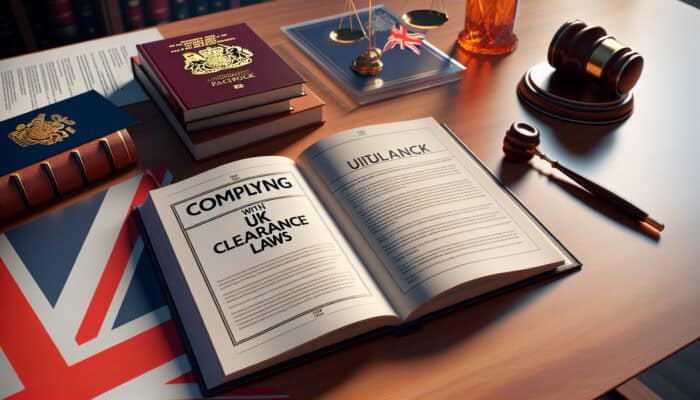Understanding UK Clearance Laws
What Are UK Clearance Laws?

How to Comply with UK Clearance Laws: UK clearance laws are regulations designed to ensure compliance and safety across sectors such as construction, environmental protection, and health and safety. These laws are essential in maintaining standards that protect not only workers but also the public and the environment. By adhering to these regulations, businesses demonstrate their commitment to responsible practices and societal well-being.
Every sector has specific clearance laws that dictate operational standards, encompassing everything from structural integrity in buildings to emissions control in manufacturing processes. Understanding these laws is crucial for any organisation operating in the UK, as they directly affect its ability to conduct business legally and ethically.
Moreover, compliance with UK clearance laws contributes to a broader objective of enhancing safety and sustaining the environment, which is increasingly significant in today’s regulatory landscape. Businesses that prioritise compliance with these laws often find themselves better positioned to navigate the complexities of compliance and avoid the repercussions of violations.
Key Legislation Governing Clearance
The foundation of UK clearance laws rests on several key pieces of legislation that provide a framework for regulatory compliance. Among them, the Building Act 1984 establishes the requirements for building safety and construction standards. This act is essential for ensuring that structures are safe for occupants and meet specific safety criteria.
Another critical piece of legislation is the Environmental Protection Act 1990, which governs waste management and pollution control. It requires businesses to assess their environmental impact and to manage waste responsibly, ensuring that activities do not harm the environment or public health.
Additionally, the Health and Safety at Work etc. The 1974 Act outlines employers’ responsibilities to ensure employees’ health and safety. This act mandates that organisations conduct risk assessments, train staff, and implement measures to mitigate workplace hazards. Together, these laws not only set the groundwork for operational compliance but also reflect a commitment to societal safety and environmental stewardship.
Importance of Compliance
Compliance with UK clearance laws is crucial for several reasons. Firstly, it helps organisations avoid legal penalties, including significant fines and even criminal charges in severe cases of non-compliance. Importantly, a robust compliance strategy fosters public safety and protects employees from harm, mitigating risks that could lead to workplace accidents or injuries.
Secondly, maintaining compliance is vital for ensuring operational integrity. Companies that adhere to these regulations are likely to experience fewer legal complications, which can disrupt operations and result in financial losses. Moreover, non-compliance can lead to reputational damage, eroding trust among customers, partners, and the broader community.
Ultimately, compliance is not merely a legal obligation; it is a strategic priority that can enhance business operations and contribute positively to overall societal welfare. Companies that view compliance laws as integral to their operations often reap long-term benefits, including improved stakeholder trust and a more resilient business model.
Expert Insights on how to comply with UK clearance laws

What Are Common Pitfalls in Compliance?
Understanding and navigating UK clearance laws can be complex, and several common pitfalls can lead to non-compliance. These include a fundamental misunderstanding of the regulations, stemming from unclear interpretation or insufficient knowledge of specific requirements. Many organisations also fall short in record-keeping, failing to maintain thorough documentation that demonstrates compliance during inspections or audits.
Additionally, businesses often fail to keep up with legislative changes, leading to outdated practices that no longer meet current standards. This is particularly relevant in a regulatory environment that is continuously evolving. Other common pitfalls include inadequate staff training, leading to unintentional violations, and a lack of engagement with legal experts who can guide on compliance matters.
- Misunderstanding regulations
- Inadequate record-keeping
- Failure to stay updated with legislative changes
- Lack of staff training on compliance
- Neglecting engagement with legal experts
- Insufficient internal compliance audits
- Over-reliance on third-party compliance services
- Inconsistent application of compliance policies
By recognising and addressing these pitfalls, organisations can significantly improve their compliance efforts and reduce the risk of legal issues, ensuring they meet the necessary standards in their operations.
How Can Businesses Stay Updated?
Staying up to date with UK clearance laws is an ongoing endeavour that requires proactive engagement from organisations. One effective approach is subscribing to regulatory updates from relevant government bodies and industry associations. These updates often include important changes in legislation and compliance requirements, ensuring businesses are informed of their obligations.
Attending seminars, workshops, and training sessions offered by legal experts or industry bodies can also be invaluable. These events provide insights into compliance best practices and emerging legislative trends, enabling organisations to adjust their strategies accordingly. Furthermore, regularly reviewing and updating internal compliance policies is essential to adapt to any legislative changes.
Another crucial element in staying updated is fostering a culture of compliance within the organisation. Encouraging staff to engage with compliance matters and share insights or concerns can lead to a more informed workforce. Establishing a dedicated compliance team or appointing a compliance officer can also help ensure ongoing oversight of compliance efforts and that the organisation remains aligned with current regulations.
Provide actionable steps for ensuring compliance.

Ensuring compliance with UK clearance laws requires a systematic approach, encompassing several actionable steps. Conducting regular audits is essential for identifying compliance gaps and ensuring that policies are effectively implemented. These audits should be comprehensive, examining all aspects of operations subject to clearance laws to ensure thorough compliance.
Training staff on compliance requirements is another critical step. This training should encompass not only the legal obligations but also practical applications, helping employees understand how their roles contribute to compliance efforts. Regular updates on regulatory changes should be included to keep the workforce informed of their responsibilities.
Establishing a dedicated compliance team can significantly improve compliance with UK clearance laws. This team should be responsible for monitoring compliance efforts, conducting internal audits, and liaising with regulatory bodies. Additionally, implementing a feedback mechanism that allows employees to report compliance concerns can lead to early identification of issues and facilitate timely resolution.
Finally, utilising technology solutions to streamline compliance processes can greatly enhance efficiency. This includes employing software to automate record-keeping, track regulatory changes, and facilitate audits, making compliance management more effective and reliable.
What Role Do Technology Solutions Play in Compliance?
Technology solutions play a pivotal role in enhancing compliance with UK clearance laws, providing tools that streamline processes and improve accuracy. One key aspect is automating record-keeping, which helps ensure that all relevant documentation is organised and easily accessible. This is particularly important during audits, when clear, accurate records are essential for demonstrating compliance.
Moreover, technology can facilitate the monitoring of regulatory changes, ensuring that businesses are promptly informed of any amendments to clearance laws that may affect their operations. Many organisations turn to compliance management software that provides real-time updates and alerts on regulatory changes, helping prevent inadvertent violations.
Additionally, technology enables audits to be conducted more efficiently. Automated tools can assist in data collection and analysis, providing insights into compliance status and identifying potential areas of concern. This not only saves time but also enhances the accuracy of compliance assessments.
- Compliance management software
- Document management systems
- Automated reporting tools
- Risk assessment software
- Training and e-learning platforms
- Data analytics tools for compliance
- Environmental monitoring systems
- Mobile applications for compliance tracking
By integrating these technology solutions, businesses can streamline their compliance efforts, making them more efficient and effective in adhering to UK clearance laws.
How Can Companies Prepare for Compliance Audits?
Preparing for compliance audits is a critical step in maintaining compliance with UK clearance laws. It begins with a thorough understanding of the audit process, which typically involves reviewing documentation, conducting site inspections, and interviewing staff. Familiarity with what to expect helps organisations approach the audit with confidence.
Maintaining comprehensive and organised documentation is paramount. All records relating to compliance, such as safety assessments, training records, and environmental reports, should be meticulously kept and readily available for review. This not only facilitates a smoother audit process but also demonstrates a commitment to compliance.
Conducting internal pre-audits can further enhance readiness. These internal reviews mimic the audit process and help identify gaps or areas for improvement before the official audit. It allows organisations to address potential issues proactively, ensuring that they are in the best possible position to pass external audits successfully.
Finally, engaging staff to ensure they understand the audit process and their roles during the audit is essential. This can include training sessions or briefings that prepare employees for potential questions and ensure they are well-informed about compliance matters.
Clearance Requirements for Different Sectors
What Are the Requirements for Construction?
Construction projects in the UK are subject to stringent clearance requirements, primarily governed by the Building Act 1984 and associated regulations. These regulations set out standards for structural integrity, fire safety, and accessibility, and compliance is mandatory for all new builds and renovations.
Key requirements include obtaining planning permissions and building regulations approval before commencing any construction work. This process involves submitting detailed plans to local councils, which assess the proposed work against established safety and environmental standards. Failure to secure the necessary approvals can result in significant delays, fines, or the requirement to halt ongoing work.
Additionally, construction projects must adhere to health and safety regulations, which necessitate conducting risk assessments and implementing appropriate safety measures to protect workers and the public. This includes ensuring that construction sites are safe and that all personnel are trained in safety practices.
Moreover, environmental clearance is increasingly becoming a critical component of construction projects, requiring builders to assess their impact on the local environment and manage waste responsibly. This holistic approach to compliance not only satisfies legal obligations but also reinforces the industry’s commitment to sustainability and public safety.
Environmental Clearance Obligations
Environmental clearance obligations in the UK are governed by the Environmental Protection Act 1990 and other related legislation. These obligations require businesses to assess their environmental impact and secure the necessary permits and approvals for their operations, particularly those that may affect land use, waste management, or pollution control.
Organisations must conduct environmental assessments to evaluate potential impacts on local ecosystems and communities. This process often involves stakeholder consultations and the submission of detailed reports to relevant authorities, such as the Environment Agency, which reviews the findings and grants necessary permits based on compliance with environmental standards.
Furthermore, businesses are mandated to implement effective waste management strategies to ensure waste is disposed of responsibly and in accordance with regulatory requirements. Non-compliance can lead to severe penalties, including fines and operational restrictions, emphasising the importance of adhering to environmental clearance obligations.
Additionally, companies must remain vigilant in monitoring their environmental performance and implementing measures to mitigate negative impacts. This includes tracking emissions and resource usage and investing in sustainable practices that enhance their overall environmental footprint.
Health and Safety Clearance Standards
Health and safety clearance standards in the UK are primarily outlined in the Health and Safety at Work etc. Act 1974, which sets forth the legal responsibilities of employers to ensure a safe working environment. Compliance with these standards is critical to preventing workplace accidents and protecting employee health.
Organisations are required to conduct comprehensive risk assessments to identify potential hazards within the workplace. These assessments should evaluate physical, chemical, and ergonomic risks, followed by the implementation of appropriate measures to mitigate identified risks. Additionally, businesses must provide adequate training and resources to ensure employees are well-informed about safety practices and protocols.
Maintaining accurate records of safety training, incidents, and risk assessments is essential for compliance. This documentation serves as evidence of adherence to health and safety regulations and is crucial during compliance audits. Failing to maintain these records can lead to non-compliance repercussions.
Furthermore, regular health and safety audits and reviews are necessary to ensure that compliance is continuously maintained. This includes monitoring workplace conditions and making necessary adjustments in response to changing regulatory requirements or operational conditions, thereby fostering a culture of safety within the organisation.
Manufacturing Clearance Guidelines
Manufacturing facilities in the UK are subject to rigorous clearance guidelines that encompass a range of safety and environmental standards. These guidelines are designed to ensure that manufacturing processes operate within legal frameworks that protect workers, consumers, and the environment.
Key clearance requirements include compliance with safety regulations governing machinery use, which mandate that all equipment be properly maintained and meet safety standards to prevent accidents. Regular inspections and maintenance schedules are essential components of compliance in this area.
Environmental standards are equally crucial, with manufacturers required to monitor emissions and implement waste disposal strategies that comply with the Environmental Protection Act. Failure to adhere to these regulations can result in severe penalties, including fines and possible operational shutdowns.
Additionally, businesses must conduct regular risk assessments to identify potential health and safety hazards associated with manufacturing processes. This proactive approach not only safeguards employees but also ensures compliance with health and safety clearance standards.
Ultimately, manufacturing clearance guidelines are designed to foster safe and sustainable operations, enabling businesses to function legally while minimising their environmental impact and ensuring worker safety.
Transportation Sector Clearances
Clearance requirements in the transportation sector are multifaceted, encompassing regulations related to infrastructure development, environmental impact, and public safety. These regulations are designed to ensure that transportation projects are safe, efficient, and environmentally responsible.
Before initiating transportation projects, companies must secure the necessary permits and approvals from relevant authorities, including local councils and transport agencies. This typically involves submitting detailed plans that outline the project’s scope, potential environmental impacts, and safety measures. Compliance with these requirements is essential for gaining approval and avoiding delays.
Environmental assessments are particularly critical in the transportation sector, as they require evaluating how projects may affect local ecosystems and communities. Companies must demonstrate that they are taking active steps to mitigate any adverse impacts, which may involve implementing sustainable practices and technologies.
Moreover, public safety considerations are paramount in transportation clearance processes. This includes ensuring that infrastructure meets safety standards and that traffic management plans are in place to protect all road users. Regular inspections and compliance audits are necessary to maintain safety standards and ensure ongoing compliance with transportation regulations.
How Are Clearance Applications Processed?
What Is the Application Process?
The UK clearance application process involves several systematic steps, ensuring that all necessary information is thoroughly reviewed before approval is granted. Initially, applicants must submit comprehensive documentation to relevant authorities, detailing the project specifications, intended scope, and compliance with applicable regulations.
Once submitted, the application often undergoes a preliminary review, where authorities assess whether the documentation meets the required standards. This stage may involve additional requests for information or clarifications to ensure that all aspects of the application are adequately addressed. Timeliness and accuracy during this phase are crucial, as incomplete or unclear submissions can lead to delays or outright rejections.
Following the preliminary review, the application typically proceeds to inspections, during which physical assessments may be conducted to evaluate compliance with regulations. This may involve site visits, safety measure assessments, and environmental impact evaluations. Once the assessments are completed, the relevant authority will then determine whether to grant approval based on adherence to the established standards.
The entire process can vary in complexity and duration depending on the nature of the project and its associated clearance requirements, and applicants must be prepared for potential delays during the review process.
Who Are the Involved Authorities?
Several authorities are involved in processing clearance applications in the UK, each playing a specific role in ensuring compliance with relevant laws and regulations. Local councils serve as the primary authority for many types of clearance applications, including those related to planning permissions and building regulations. They are responsible for reviewing submissions, conducting inspections, and enforcing adherence to local regulations.
The Health and Safety Executive (HSE) is another key authority, particularly in matters related to workplace safety and health regulations. The HSE oversees compliance with health and safety standards, ensuring that organisations maintain safe working environments.
Additionally, the Environment Agency plays a crucial role in processing applications related to environmental clearance. This includes assessing the potential environmental impacts of projects and ensuring compliance with waste management and pollution control regulations.
Collaboration among these authorities is essential to process clearance applications and uphold regulatory standards effectively. Applicants should understand the roles of each authority and ensure that they provide all necessary information relevant to the specific jurisdiction when submitting applications.
Timelines and Approval Criteria
Timelines for clearance approval can vary significantly depending on the sector, complexity of the application, and specific requirements of the project. Generally, the process can take anywhere from a few weeks to several months. For straightforward applications, such as minor building renovations, approvals are often granted relatively quickly.
However, more complex projects, especially those requiring extensive environmental assessments or comprehensive planning permissions, may experience longer processing times. Applicants must factor these timelines into their project planning to avoid delays.
Approval criteria are grounded in the need to ensure compliance with established regulations. Authorities will evaluate submitted documentation against safety, environmental, and operational standards. This includes assessing risk management strategies, environmental impact mitigation efforts, and the project’s overall feasibility in relation to regulatory requirements.
Successful applications typically exhibit thorough planning, detailed documentation, and a robust approach to compliance, thereby increasing their chances of timely approval.
What Are Common Delays in Processing?
Common delays in processing clearance applications can arise from various factors, often related to the completeness and clarity of submitted documentation. Incomplete applications frequently lead to backlogs, requiring authorities to return submissions for additional information, thereby prolonging the review process.
Backlogs at the authorities themselves can also contribute to delays, especially during periods of high application volumes. In such cases, applicants may find themselves waiting longer than anticipated for reviews and inspections. Seasonal fluctuations, such as those experienced during the summer months, can further exacerbate these delays.
Additionally, requests for further inspections or clarifications may arise during the review process, particularly for complex projects. These additional requirements necessitate further coordination between applicants and authorities, leading to potential setbacks.
- Incomplete applications
- Backlogs at regulatory authorities
- Requests for additional inspections
- Insufficient staffing at review bodies
- Complexity of the project
- Changes in legislation affecting requirements
- Failure to meet submission deadlines
- Insufficient stakeholder engagement
To mitigate these delays, applicants should ensure their submissions are thorough and accurate, reducing the likelihood of additional requests for information that could slow the approval process.
How Can Applicants Appeal Decisions?
Applicants have the right to appeal clearance decisions made by UK regulatory authorities, particularly if they believe the decision was unjust or based on incomplete information. The appeal process typically involves submitting a formal appeal to the relevant authority, often within a specified timeframe following the decision.
The appeal submission must clearly outline the grounds for the appeal and provide any additional evidence or arguments supporting the case. This may include new information that was not considered during the initial review or clarifications regarding the project’s compliance with regulations.
Once the appeal is submitted, the relevant authority will review the case, which may involve reinspection of the project or additional assessments to evaluate the appeal’s validity. Depending on the outcome, the authority may either uphold the original decision or grant approval based on the new evidence provided.
Applicants need to be aware of the specific appeal procedures and timelines outlined by the relevant authority, as these can vary. Engaging with legal experts during this process can also provide valuable guidance and improve the chances of a successful appeal.
Research-Backed Benefits of how to comply with uk clearance laws
Offer expert analysis on the benefits of compliance
Expert analysis shows that compliance with UK clearance laws provides myriad benefits to organisations across various sectors. Firstly, compliance significantly reduces legal risks. By adhering to established regulations, companies can avoid the costly consequences of legal penalties or litigation stemming from non-compliance.
Furthermore, maintaining compliance enhances an organisation’s reputation. Businesses known for their commitment to safety and regulatory compliance build trust with customers, partners, and the public. This positive perception can lead to increased customer loyalty and attract new clients who prioritise responsible practices.
Additionally, compliance fosters a culture of safety and responsibility within the organisation. Employees who are trained and aware of compliance matters are more likely to contribute to a safe working environment, leading to fewer accidents and improved morale. This cultural shift not only benefits employees but also enhances overall operational efficiency.
Moreover, compliance can improve operational efficiency. By streamlining processes to align with regulatory requirements, organisations can eliminate inefficiencies, enhance productivity, and ultimately lower costs associated with legal issues and operational disruptions.
How Does Compliance Impact Business Operations?
Compliance with UK clearance laws directly impacts business operations, necessitating changes in processes, documentation, and training. Organisations must often adapt workflows to ensure compliance with regulatory requirements, which may involve implementing new procedures for record-keeping, safety assessments, and employee training.
While these changes may require initial investments in time and resources, they ultimately streamline operations and facilitate a more efficient working environment. Compliance can lead to enhanced operational consistency, minimising the risks associated with non-compliance and helping businesses maintain smooth, uninterrupted operations.
Moreover, compliance requires regular staff training and updates, ensuring they remain informed about their responsibilities and the latest regulatory changes. This continuous education can foster a more knowledgeable workforce, capable of identifying potential compliance issues before they escalate.
In the long run, businesses that prioritise compliance find that it not only reduces risks but also enhances their operational reputation. This strategic focus on compliance can serve as a competitive advantage, differentiating organisations in increasingly competitive markets.
Long-Term Advantages of Compliance
Long-term benefits of compliance with UK clearance laws include sustained regulatory compliance and reduced legal costs. By establishing a culture of compliance, organisations can create an environment that prioritises safety and responsibility, leading to long-term success and stability.
Additionally, compliance fosters increased trust from stakeholders, including customers, employees, and investors. A strong compliance record can enhance an organisation’s credibility, making it more attractive to potential partnerships and opportunities.
Moreover, businesses that actively comply with clearance laws are better positioned to respond to regulatory changes. This adaptability allows organisations to maintain operational continuity and avoid disruptions arising from sudden regulatory shifts.
In essence, compliance is not merely a legal obligation but a strategic investment in a business’s longevity. By adhering to clearance laws, organisations can create a solid foundation for growth and resilience in an ever-evolving regulatory landscape.
What Are the Consequences of Non-Compliance?
Legal Penalties and Fines
Non-compliance with UK clearance laws can lead to severe legal penalties, including substantial fines and potential criminal charges. The severity of these penalties often depends on the nature and extent of the violation, with more egregious cases resulting in harsher consequences.
For instance, businesses that fail to adhere to health and safety regulations may face significant fines imposed by regulatory authorities, which can reach hundreds of thousands of pounds in extreme cases. In some situations, non-compliance can lead to criminal charges against responsible individuals within the organisation, potentially resulting in imprisonment.
Moreover, the financial implications of non-compliance extend beyond fines. Legal battles stemming from violations can drain resources and distract management from core business operations, ultimately impacting the organisation’s bottom line.
In light of these risks, prioritising compliance with UK clearance laws is essential to safeguard both legal and financial interests.
Impact on Business Reputation
The impact of non-compliance on a business’s reputation can be devastating. Companies found to violate clearance laws may suffer significant loss of trust and credibility among customers, partners, and the public. This reputational damage can lead to decreased customer loyalty, as consumers increasingly prefer to engage with businesses that prioritise safety and compliance.
Recovering from a damaged reputation can be a long and costly process. The negative publicity associated with non-compliance can linger, leading to ongoing scepticism among stakeholders. Businesses may need to invest considerable resources in public relations campaigns to repair their image, diverting attention and funds from core operations.
Ultimately, a strong compliance record is essential for maintaining a positive reputation. Organisations should view compliance not only as a legal obligation but also as a vital element of their branding and customer relations strategy.
Operational Disruptions
Non-compliance can lead to significant operational disruptions, manifesting in project delays, shutdowns, and increased scrutiny from regulatory authorities. When a company is found non-compliant, it may be forced to halt operations until issues are resolved, with dire financial implications and disrupted service delivery.
Moreover, increased scrutiny from authorities can lead to more frequent inspections and audits, compounding operational challenges. This heightened oversight can strain resources and detract from the ability to focus on core business objectives.
For example, a construction project that fails to comply with building regulations may be halted, resulting in contractual penalties and loss of client trust. Such disruptions significantly affect a business’s ability to meet deadlines and maintain profitability, underscoring the critical role of compliance in operational success.
- Project delays
- Operational shutdowns
- Increased regulatory scrutiny
- Financial penalties
- Loss of client trust
- Disruption of supply chains
- Decreased employee morale
- Reduced competitiveness in the market
Therefore, ensuring compliance is not just about avoiding penalties; it is essential for maintaining smooth, efficient business operations.
Strategies for Maintaining Compliance
Implementing Regular Audits
Implementing regular audits is a fundamental strategy for maintaining compliance with UK clearance laws. Audits serve as an essential tool for identifying compliance gaps and ensuring continuous adherence to regulatory requirements. Establishing a systematic auditing schedule allows organisations to conduct thorough assessments of their compliance status, evaluating all relevant processes and practices.
During audits, organisations should review documentation, assess operational practices, and verify that all employees comply with established compliance policies. This comprehensive approach not only identifies potential issues but also reinforces a culture of accountability within the organisation.
Furthermore, audits should be both internal and external, with internal audits allowing organisations to assess their compliance proactively. In contrast, external audits provide an opportunity to receive impartial evaluations from third parties. Engaging external auditors can yield valuable insights and recommendations to enhance compliance strategies.
Ultimately, regular audits are essential for maintaining regulatory adherence and ensuring that organisations remain up to date with evolving compliance requirements.
Training and Education for Staff
Staff training and education play a pivotal role in maintaining compliance with UK clearance laws. A well-informed workforce is essential for ensuring that all employees understand their roles and responsibilities regarding compliance, thereby fostering a culture of safety and accountability within the organisation.
Organisations should develop comprehensive training programs that cover the specific compliance requirements relevant to their operations. This includes regular updates on regulatory changes and best practices, ensuring employees remain informed of their obligations. Interactive training sessions that engage staff in discussions about compliance challenges can enhance understanding and retention of vital information.
Moreover, ongoing education is crucial, as it allows organisations to adapt to changes in legislation and industry standards. By investing in staff training, organisations not only enhance compliance but also empower employees to take an active role in upholding safety and operational standards.
Ultimately, a continuous focus on training and education is essential for maintaining compliance and ensuring that staff are equipped to navigate the complexities of regulatory requirements.
How Can Technology Aid Compliance?
Technology can significantly aid compliance with UK clearance laws by providing tools that streamline processes and improve accuracy. A range of software solutions exists to assist organisations in tracking regulations, maintaining documentation, and facilitating audits. These technologies help reduce the burden of compliance management, allowing organisations to focus on their core operations.
For instance, compliance management software can automate record-keeping processes, ensuring that all relevant documentation is organised and easily accessible. This is particularly beneficial during audits, where prompt access to records is essential for demonstrating compliance.
Additionally, technology can support risk assessments and monitoring, making it easier for organisations to stay up to date on regulatory changes and assess their compliance status in real time. Data analytics tools can provide insights into compliance trends, enabling businesses to identify areas for improvement proactively.
- Compliance management software
- Document management systems
- Automated reporting tools
- Risk assessment software
- Training and e-learning platforms
- Data analytics tools for compliance
- Environmental monitoring systems
- Mobile applications for compliance tracking
By leveraging technology, organisations can enhance their compliance efforts, ensuring alignment with UK clearance laws while improving operational efficiency and accuracy.
Establishing Clear Compliance Policies
Establishing clear compliance policies is essential for maintaining adherence to UK clearance laws within organisations. These policies should outline the specific compliance requirements relevant to the organisation’s operations, providing employees with a roadmap for understanding their responsibilities.
Compliance policies must be communicated effectively throughout the organisation, ensuring that all staff members are aware of the standards they are expected to meet. Regular training sessions should reinforce these policies and provide updates on any regulatory changes that may affect compliance.
Moreover, organisations should establish mechanisms for feedback and reporting, enabling employees to raise compliance concerns or suggest improvements. This can foster a culture of accountability and transparency, where staff feel empowered to contribute to compliance efforts.
Ultimately, clear compliance policies not only promote adherence to legal obligations but also enhance overall organisational integrity and ethical standards.
FAQs
What are UK clearance laws?
UK clearance laws are regulations designed to ensure safety and compliance in various sectors, including building, environmental protection, and health and safety.
Why is compliance with clearance laws important?
Compliance is crucial to avoid legal penalties, ensure public safety, maintain operational integrity, and protect a company’s reputation.
What are common pitfalls businesses face in compliance?
Common pitfalls include misunderstanding regulations, inadequate record-keeping, failing to stay up to date, and insufficient staff training.
How can businesses stay up to date on compliance requirements?
Businesses can stay updated by subscribing to regulatory updates, attending seminars, and regularly reviewing compliance policies.
What are actionable steps for ensuring compliance?
Actionable steps include conducting regular audits, training staff, and establishing a dedicated compliance team.
How can technology aid compliance management?
Technology can streamline compliance management through automated record-keeping, monitoring regulatory changes, and facilitating audits.
What are the consequences of non-compliance?
Consequences include legal penalties, reputational damage, and operational disruptions, which can significantly affect business performance.
What is the role of local councils in clearance applications?
Local councils review and approve applications for building regulations and planning permissions, ensuring compliance with local safety and environmental standards.
How can applicants appeal clearance decisions?
Applicants can appeal decisions by submitting a formal appeal to the relevant authority, outlining the grounds for the appeal and providing supporting evidence.
What is the importance of compliance training?
Training ensures that employees understand their compliance responsibilities, promoting a culture of safety and accountability within the organisation.






